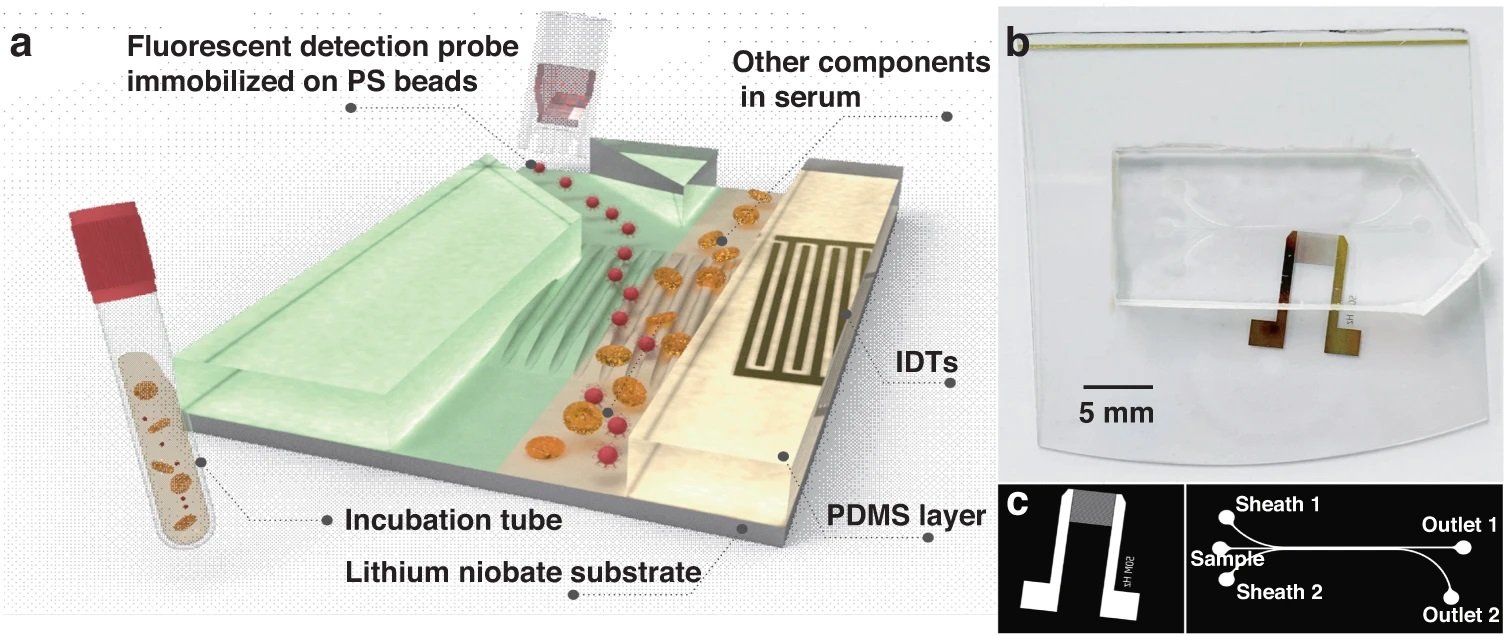
14 Nov Microfluidic Chip with Surface Acoustic Wave Technology for Cardiac Biomarker Detection
In the realm of cardiovascular health, timely and accurate detection of biomarkers is crucial. Acute myocardial infarction (AMI), commonly known as a heart attack, is a life-threatening condition that necessitates prompt diagnosis. The biomarker cardiac troponin I (cTnI) plays a pivotal role in diagnosing AMI. However, traditional methods of detecting cTnI face challenges due to the interference of biological molecules in body fluids, which can hinder sensitivity. A recent study published in Nature Microsystems & Nanoengineering introduces a microfluidic approach to enhance the detection of cTnI in human serum. This method leverages surface acoustic wave (SAW) technology integrated into a microfluidic device, offering a significant improvement in detecting this vital cardiac biomarker.
” In order to solve this problem, in this study, surface acoustic wave separation is designed to purify the target to achieve more sensitive detection performance of fluorescent detection. Specifically, the interference of background noise is almost completely removed on a microfluidic chip by isolating microbeads through acoustic radiation force, on which the biomarkers are captured by the immobilized detection probe.“, the authors explained.

“a The schematic of SAW microfluidic chip. b SAW device fabricated by us. c 50 MHz IDTs designed. d Microfluidic chip designed” Reproduced from Chen, X., Zhang, C., Liu, X. et al. Low-noise fluorescent detection of cardiac troponin I in human serum based on surface acoustic wave separation. Microsyst Nanoeng 9, 141 (2023). under Creative Commons Attribution 4.0 International License.
Microfluidic Device Design and Functionality
The core of this microfluidic device is a SAW-based chip, designed to isolate cTnI attached to the surface of polystyrene (PS) beads, thereby reducing interference from serum components. The chip comprises a lithium niobate substrate with interdigitated transducers (IDTs) and a polydimethylsiloxane (PDMS) microchannel. The IDTs, with 30 pairs of electrodes, are meticulously designed with a width and pitch of 20 µm, generating a TSAW wavelength close to 80 µm.
The microchannel features three inlets: two for sheath flows and one for sample injection. By manipulating the sheath flows, researchers can adjust the sample flow’s width and position within the channel. The main channel is 3 µm wide, with a 2 µm wide branch for collecting target particles separated by SAW, and another 150 µm wide branch.
The microfabrication of the microfluidic chip involves several intricate steps:
1- Patterning IDTs: Using photolithography, IDTs are patterned on the lithium niobate substrate. This involves spin coating with photoresist, mask alignment, and development..
2- Metal Layer Deposition: A Cr layer (50 nm) and an Au layer (2 nm) are deposited via electron beam evaporation.
3- PDMS Microchannel Fabrication: Employing soft lithography, the PDMS microchannel chip is created. The process includes photolithography on a silicon substrate, coating with SU8 photoresist, and development.
4- Assembly: The PDMS chip and lithium niobate substrate are cut, treated with oxygen plasma, and manually bonded under a microscope, ensuring precise alignment.

“a The detection mechanism of competitive assay. b Detection process of our detection method” Reproduced from Chen, X., Zhang, C., Liu, X. et al. Low-noise fluorescent detection of cardiac troponin I in human serum based on surface acoustic wave separation. Microsyst Nanoeng 9, 141 (2023). under Creative Commons Attribution 4.0 International License.
The researchers developed a microfluidic chip that employs SAW to create a high-energy density acoustic field. This field targets particles in the chip, enabling efficient separation of cTnI-bound microbeads from other serum components. The biosensor’s detection limit, determined by the 3K method, is impressively low at 44 pg/mL in PBS buffer and 0.34 ng/mL in human serum, showcasing superior sensitivity over traditional methods.The detection mechanism is based on a competitive assay using a cTnI aptamer modified with a fluorescent dye and a ssDNA with a gold nanoparticle. The assay is immobilized on 10 µm PS beads. The presence of cTnI leads to the release of ssDNA due to higher binding affinity, altering the fluorescence resonance energy transfer (FRET) effect and enabling the detection of cTnI concentration through fluorescence intensity variations.
To validate this method’s clinical reliability, the results were compared with tests conducted using a nephelometric analyzer in a hospital setting. The comparison underscored the accuracy and clinical applicability of this SAW-based detection method.
“This detection method can realize rapid and accurate detection of cTnI level in human serum, and its performance has been validated by comparison with results of clinical test. What’s more, with the advantage of automatic separation process by SAW, this method has great potential for developing portable detection devices in the future.“, the authors concluded.
For more insights into the world of microfluidics and its burgeoning applications in biomedical research, stay tuned to our blog and explore the limitless possibilities that this technology unfolds.
Figures are reproduced from Chen, X., Zhang, C., Liu, X. et al. Low-noise fluorescent detection of cardiac troponin I in human serum based on surface acoustic wave separation. Microsyst Nanoeng 9, 141 (2023). https://doi.org/10.1038/s41378-023-00600-5 under a Creative Commons Attribution 4.0 International License)
Read the original article: Low-noise fluorescent detection of cardiac troponin I in human serum based on surface acoustic wave separation


